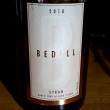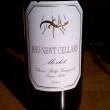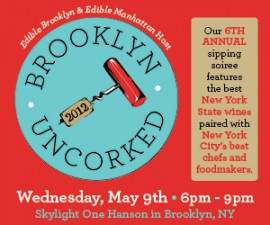TasteCamp 2009: An Interview with Lyle Fass
Today, talk with the one, the only Lyle Fass about his experiences at TasteCamp EAST 2009. Lyle has been in and around wine since he was 19. Of course he started
drinking it when he was 21.
Most of his background is in retail buying
for Crush, Chambers Street Wines and The Wine Shop in Manhattan. Before
he arrived in NYC he he learned the ropes of retail in Boston at The
Wine Press, Brookline Liquor Mart and The Wine Bottega.
His blog Rockss
and Fruit has a loyal, devoted readership and has been featured
numerous times in the paper of record, the New York Times.
Burgundy, Austria and some Rhone plus many backwood appelation French
Wines.
Was this your first time to Long Island wine country?
Yes
Had you ever had any Long Island wines before? And if so, what was your impression of them?
Yes I had. My impression was overoaked and insipid wines that really had no character.
After tasting a larger sample of the wines being produced on Long Island, what is your impression now?
My new impression is that the wines have greatly improved but there still is a lot of work to be done.
What grape or variety, in general, impressed you the most?
Chenin blanc. I do not understand why more is not planted.
What grape or variety, in general, underwhelmed you the most?
Merlot. The terroir just will not lift it to the heights of say St. Emillion or Pomerol. If the terroir you have is not perfect for merlot it turns out pretty boring which was my impression of most of the merlot I tasted. I did however like 2005 Paumanok as it was gritty, earthy and had lovely structure and was not trying to be something it was not.
Was there a winery or tour stop that stands out in your mind as the "best"?
Shinn. No questions asked. Lunch, tasting and vineyard tour. Just like the Old World!
If you had to pick one, what would your wine of the weekend be?
2005 Paumanok Merlot (White Label)


















Lyle: I often ask myself the same question about the chenin blanc. Paumanok does great things with it…and I’m surprised that no one else has jumped on that opportunity.
Perhaps some of the industry people who read LENNDEVOURS can offer some insight?
Lyle’s Rockss and Fruit was the very first wine blog I started reading- and I’m still reading it.
The dude is sharp! I wish I had 1/20th of his skillz!
When I first read Lyle comment, “Merlot. The terroir just will not lift it to the heights of say St. Emillion or Pomerol,” My response was, “Well no kidding. We’re talking about the prime terroir in the world for that grape.”
But his next comment, “If the terroir you have is not perfect for merlot it turns out pretty boring which was my impression of most of the merlot I tasted,” I assumed that Lyle doesn’t drink Merlot at all outside Bordeaux. It’s a strong assertion, and I can’t say I completely disagree. It is, however, the first time I’ve ever heard someone say that a varietal grown outside its worldwide sweetspot is almost universally “boring.”
I would have liked to have read his comments on Cabernet Franc….
Evan,
The first time I tasted Merlot from Friuli Venezia Giulia (it’s been growing there for over 100 years) I learned that there is Bordeaux earth and there are other earths.
I respect Lyle’s palate, too, but often we become palate blind to what we prefer rather than to explore what we may not understand just yet. I wouldn’t put Northeastern Italy’s Merlot against Pomerol and expect one or the other to be anywhere close to one or the other-I would expect them to offer unique possibilities.
As Dan Berger often says, and I paraphrase, instead of trying to get from one place the taste and experience of another place, it’s much more fun to understand what each place has to offer. You will prefer some over others, but blanket condemnation means that you think you have the answer-and none of us have a lock on that.
Having said that, after tasting Riesling from Northern California two weeks ago, I want to propose that half the places in the world that try to produce Riesling ought to stop trying…
Man, I *knew* this one was gonna be a *gem*! Sweet…
Thanks for all the comments.
Cabernet Franc has potential but it seems most of the winemakers are taking the green out which is no good for me as that is what CF is all about, of course in moderation.
Evan,
I do not drink Merlot outside of Bordeaux but have tasted bucketloads of it and I still stand by my statement.
Lyle,
That’s your Chinon brain talking-and I agree!!!
You need a Finger Lakes Cabernet Franc…although ’07 might be an anomaly.
Tom (and others),
Regarding sense of place, I’d say this is where the Finger Lakes is strides ahead of Long Island. The best Finger Lakes winemakers will never pontificate on how similar our terroir is to Alsace or Mosel or Austria; they’ll never tell you that we’re making a resonable facsimile of Riesling from those regions. The best speak in terms of the unique offering our own sense of place. As a result, Finger Lakes Riesling is emerging with its own profile, distinct from Alsace and Mosel, and gorgeous in its own right. (This sounds like a post subject for me).
On the other hand, while I hear Long Island winemakers speak eloquently on their own sense of place, it’s often coupled with a lot of talk about similarities to France, opportunity to mirror the results of other regions, etc. As someone who has spent plenty of time in marketing conferences and meetings, I understand this impulse, but when I ask, “What does it mean when we talk about Long Island Merlot?” or “What does it mean when we talk about Long Island Cab Franc?”, more often than not I’m told of similarities to France. That just impedes the progress in establishing LI’s own unique qualities.
Evan: You just hit on something interesting…and true. I can count on one hand the number of times that a Finger Lakes winemaker has, when discussion his or her riesling, mentioned any of the “classic” regions for the grape.
That said, there are a few things (well, more than a few but we’ll target a couple) different between LI and FL.
One, the Finger Lakes wine region is older. Already I’ve noticed a difference in how often I hear the Bordeaux comparison. My guess is that once LI is as old as the FL region is now, it will drop even further.
And this one might get me in trouble with some of my Pacific Northwest readers, but the Finger Lakes don’t NEED to use comparisons to differentiate styles because, honestly, no one in the U.S. is doing riesling anywhere near as well as the Finger Lakes!
I can’t say for sure, but I have a feeling that most of the time the Bordeaux comparisions are meant to quickly and definitively differentiate Long Island merlot from west coast versions. And while there are PLENTY of differences between Long Island and Bordeaux, stylistically, they are much closer than Long Island and Napa.
By saying “Bordeaux” wineries can shift a customer’s reference point quickly.
I don’t think Finger Lakes producers need to do that as much because there isn’t a U.S. region that is known for riesling.
Of course, it can also be said that they don’t compare themselves to Alsace/Mosel/Austria because the wine truly ARE unique. Finger Lakes winemakers have really honed in on the uniqueness of the region.
I think that Long Island is headed in that direction, but it’s not quite there. And because we’re talking reds, which typically spend 12-24 months in oak, the “turnover” isn’t as brisk as the Finger Lakes either!
Maybe some of these differences are why NY wineries as a whole do a crappy job marketing themselves as a state, rather than individual regions and wineries.
Take it from an old-timer: 25 years ago, it was not uncommon to hear someone in a Finger Lakes tasting room explain that, “this Riesling will remind you of Germany,” or “this Gewurztraminer is made in the Alsatian style.”
It takes time to build and even to accept your own wine identity. It took the Finger Lakes a total of 30 years to close that book with Riesling.
Tom and Lenn,
Great points. And Lenn, it’s rather shrewd of LI winemakers to turn a consumer’s attention east rather than west. More accurate on balance, too. I simply look forward to being able to understand the concept of LI’s sense of place without relating it elsewhere. No doubt that day is coming.
Evan and Lenn,
From a point of access to the market, I’d guess that New Yorkers are quite familiar with Bordeaux and so the reference tickles an already ‘funny’ bone.
Believe it or not, many California producers still complain about the difficulty of getting into the NY City market. It’s a port city with access to everything possible form across the Atlantic-always has been. California always has been an enigma in NYC.
Still, LI is a maritime climate and that brings it more in line with Bordeaux than with Napa.
Re, Riesling, when Finger Lakes producers didn’t yet have their identity, it was risky to mention Germany, as only a select group of wine drinkers knew of the great German wines, while so many Americans thought of Riesling as Blue Nun!
Evan - it has nothing to do with being shrewd - that’s not the right word. It has more to do with the reality of our experience and trying to educate our consumers. Let’s remember a little history shall we?
When Long Island first began producing wines, NYS wine was still fighting the “NY wines are made from labrusca and are foxy” stigma. So much so that Alex Hargrave fought and won the right to have the word “State” removed from wine label usage so the term “New York” alone could be used. We couldn’t explain our wines by saying they tasted like they were grown in New York, or on Long Island - we had to convince people our wines would not taste like concord and niagara! Many people were afraid to even try them. The L.I. industry worked at separating itself from what was then a NY industry that was in disarray and had a poor history of quality.
In NYC especially - where there are more francophiles than taxi cabs - it became easier to explain that our wines were more like those of the old world. It’s also how we learned to make better wines - we sure didn’t do that by following California’s recommendations and examples.
The Finger Lakes dealt with the quality issue in its own way, focusing more and more on vinifera as the brand leader. And I remember many a description of “Alsation style” coming from Hermann Wiemer back in the day - not to mention the parade of German researchers and winemakers that would spend days in the Finger Lakes visiting and speaking - which I’m sure has been a tremendous help to the region.
Thought you all needed to be reminded of this not-so -ancient history. People need to remember also that the L.I. industry is less 35 years old - 25 years really since the first 10 years were represented by just one winery. We had the baggage of NY wine industry’s past, the remnants of Prohibition (i.e. state laws, politcal issues) and a challenging climate. I think we’ve done pretty damn good and we’ll continue figuring out the rest going forward!
Lyle - it was pleasure meeting you. But I do have to profoundly disagree with your assessment of our terroir. I do hope you’ll visit us again to learn more about our region and come to a better understanding of our wines.
What is wrong with comparing? When a consumer is not fully aware of a product qualities, it is not uncommon to try and relate that product to one which is more commonly available to the consumer.
If you have never tasted the spice Sumac it would be helpful if we can find words to describe its qualities, but the shortage of words to describe flavor leads us to use analogues. After all isn’t it the way we describe wines? And isn’t Bordeaux, as an example, now a generic analogue?
Furthermore as was stated by others, LI is a young region. There is not yet a single set of qualities that strongly describe its wines, except for the fact that it is a cool climate region with wines that tend to be lower in alcohol, therefore conserve acidity, making them more food friendly. But that is not the description that is at stake in this conversation.
As to Merlot, as an example, there is such disparity from one producer to the next that it is not possible to generalize. These differences may be more attributable to clonal selections than terroir or winemaking/growing: as a yound region our vines are procured haphazardly from one nursery or another, depending on availability price and clonal qualities and therefore the genetic material is much more diverse than a region that has long ago planted with much more uniformity as there were far fewer choices.
Unfortunately a lot of thse conversation want to reach a quick and general conclusion , but it is never so simple if ones wants to be thorough.
Well said Charles. Also if I may add, the realization of varietal character and the expression of local terroir is achieved somewhat quicker with white wine varieties. We see this with sauvignon blanc on Long Island where after only a few years we can see and begin to identify the character of these wines. I think many in the Finger Lakes would agree when it comes to Riesling. Not that more dramatic results will not be evident in the future - I am sure of that. But when discussing the full realization of red varieties like merlot, cab franc, petit verdot or pinot noir, it can takes many decades before the vines achieve the age where they will have the density and complexity they are capable of. At the risk of making another comparison (but I have to, sorry) the best producers in Bordeaux only use wines made from vineyards that are over 30 years of age in their top wines. I believe they know what they’re doing
I also believe we are only now starting to see this in our wines - that’s why I’m a firm believer that our truly best work is ahead of us.
Lyle’s right!
Don’t lose that subtle green note in your cab franc.
As for the Chenin Blanc, I’d still like to know what disadvantages it has in terms of growing it in the vineyards and climate of L.I. in comparison to Sauvignon Blanc.
Also, I get the feeling that some LI wineries like to use the Bordeaux comparison as a way to boost prices. When I visited a couple of weeks ago, I was amazed at some of the prices being charged.
Bryan - Cab Franc is naturally herbal even at its peak of ripeness - so I would not characterize these flavors as “green” which assumes this is an unripe condition. The only way I’ve seen winemakers reduce this character is by blending with another variety (i.e. Cab Sauv, Merlot) or by using a lot of new oak. I’ve also tasted a few made by thermo-vinification which extracts more color and reduces the herbaciousness. To me, these techniques do not allow the true character of the Cab Franc to shine through. That’s why I’ve been a big proponent of stainless steel aging for this variety on Long Island. Also, research out of Cornell is showing that these herbal flavors are not necessarily due to methoxypyrazines as was once thought but from some other biological pathway.